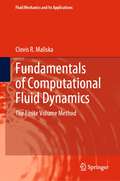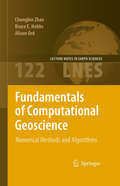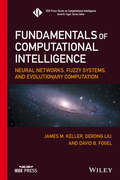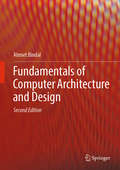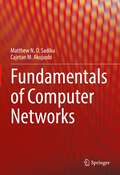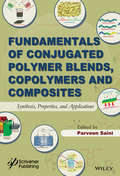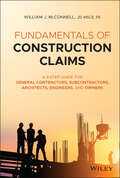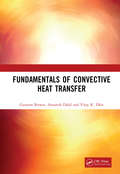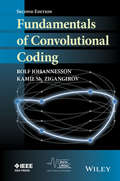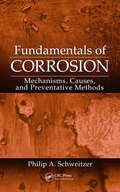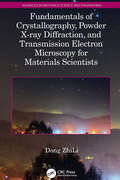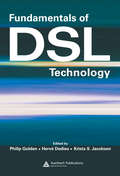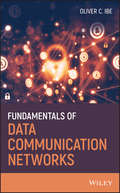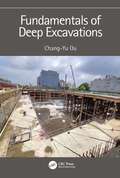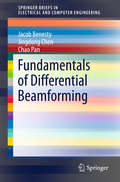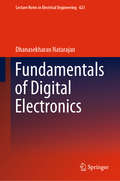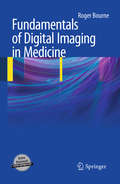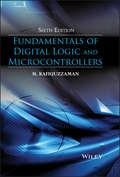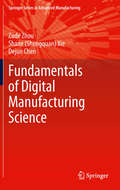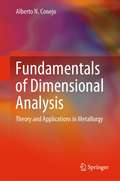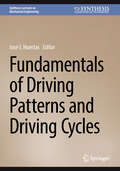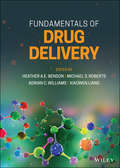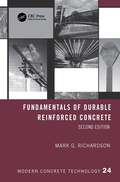- Table View
- List View
Fundamentals of Composites and Their Methods of Fabrications: PMCs, MMCs, and CMCs
by Bahram FarahmandThis book provides readers with essential insights into composite materials, encompassing methods for fabricating composite parts (PMCs, MMCs, CMCs), determining their mechanical properties via coupon testing and rule of mixtures, and exploring their industrial applications. Additionally, the book covers topics of interest for engineers, including damage tolerance analysis, nondestructive inspections, repairing damaged composite and metallic parts, and fabricating composite parts using additive manufacturing processes. Drawing on his years of experience in the aerospace industry, the author believes the topics presented will be valuable to readers and that engineers in industries, students in academia, and university instructors will find this book beneficial. Introduces progressive failure analysis, fatigue, and fracture of composite, molecular dynamics, virtual testing, with several practical example problems Explores additive manufacturing methods and their application in fabricating PMCs and assessing mechanical properties Introduces nanocomposites and their fabrication methods, detailing advantages and disadvantages of the parts produced
Fundamentals of Computational Fluid Dynamics: The Finite Volume Method (Fluid Mechanics and Its Applications #135)
by Clovis R. MaliskaThis book presents the developments of the finite volume method applied to fluid flows, starting from the foundations of the method and reaching the latest approaches using unstructured grids. It helps students learn progressively, creating a strong background on CFD. The text is divided into two parts. The first one is about the basic concepts of the finite volume method, while the second one presents the formulation of the finite volume method for any kind of domain discretization. In the first part of the text, for the sake of simplicity, the developments are done using the Cartesian coordinate system, without prejudice to the complete understanding. The second part extends this knowledge to curvilinear and unstructured grids. As such, the book contains material for introductory courses on CFD for under and graduate students, as well as for more advanced students and researchers.
Fundamentals of Computational Geoscience
by Bruce E. Hobbs Alison Ord Chongbin ZhaoThis monograph aims to provide state-of-the-art numerical methods, procedures and algorithms in the field of computational geoscience, based on the authors' own work during the last decade. Although some theoretical results are provided to verify numerical ones, the main focus of this monograph is on computational simulation aspects of the newly-developed computational geoscience discipline. The advanced numerical methods, procedures and algorithms presented are also applicable to a wide range of problems in both geological length-scales and engineering length-scales. In order to broaden the readership, common mathematical notations are used to describe the theoretical aspects of geoscience problems, making it either an invaluable textbook for postgraduate students or an indispensable reference book for computational geoscientists, mathematicians, engineers and geoscientists.
Fundamentals of Computational Intelligence: Neural Networks, Fuzzy Systems, and Evolutionary Computation
by Derong Liu James M. Keller David B. FogelProvides an in-depth and even treatment of the three pillars of computational intelligence and how they relate to one another This book covers the three fundamental topics that form the basis of computational intelligence: neural networks, fuzzy systems, and evolutionary computation. The text focuses on inspiration, design, theory, and practical aspects of implementing procedures to solve real-world problems. While other books in the three fields that comprise computational intelligence are written by specialists in one discipline, this book is co-written by current former Editor-in-Chief of IEEE Transactions on Neural Networks and Learning Systems, a former Editor-in-Chief of IEEE Transactions on Fuzzy Systems, and the founding Editor-in-Chief of IEEE Transactions on Evolutionary Computation. The coverage across the three topics is both uniform and consistent in style and notation. Discusses single-layer and multilayer neural networks, radial-basis function networks, and recurrent neural networks Covers fuzzy set theory, fuzzy relations, fuzzy logic interference, fuzzy clustering and classification, fuzzy measures and fuzzy integrals Examines evolutionary optimization, evolutionary learning and problem solving, and collective intelligence Includes end-of-chapter practice problems that will help readers apply methods and techniques to real-world problems Fundamentals of Computational intelligence is written for advanced undergraduates, graduate students, and practitioners in electrical and computer engineering, computer science, and other engineering disciplines.
Fundamentals of Computer Architecture and Design
by Ahmet BindalThis textbook provides semester-length coverage of computer architecture and design, providing a strong foundation for students to understand modern computer system architecture and to apply these insights and principles to future computer designs. It is based on the author’s decades of industrial experience with computer architecture and design, as well as with teaching students focused on pursuing careers in computer engineering. Unlike a number of existing textbooks for this course, this one focuses not only on CPU architecture, but also covers in great detail in system buses, peripherals and memories. This book teaches every element in a computing system in two steps. First, it introduces the functionality of each topic (and subtopics) and then goes into “from-scratch design” of a particular digital block from its architectural specifications using timing diagrams. The author describes how the data-path of a certain digital block is generated using timing diagrams, a method which most textbooks do not cover, but is valuable in actual practice. In the end, the user is ready to use both the design methodology and the basic computing building blocks presented in the book to be able to produce industrial-strength designs.
Fundamentals of Computer Networks
by Cajetan M. Akujuobi Matthew N. SadikuThis textbook presents computer networks to electrical and computer engineering students in a manner that is clearer, more interesting, and easier to understand than other texts. All principles are presented in a lucid, logical, step-by-step manner. As much as possible, the authors avoid wordiness and giving too much detail that could hide concepts and impede overall understanding of the material. Ten review questions in the form of multiple-choice objective items are provided at the end of each chapter with answers. The review questions are intended to cover the little “tricks” which the examples and end-of-chapter problems may not cover. They serve as a self-test device and help students determine how well they have mastered the chapter.
Fundamentals of Conjugated Polymer Blends, Copolymers and Composites
by Parveen SainiSince their discovery in 1977, the evolution of conducting polymers has revolutionized modern science and technology. These polymers enjoy a special status in the area of materials science yet they are not as popular among young readers or common people when compared to other materials like metals, paper, plastics, rubber, textiles, ceramics and composites like concrete. Most importantly, much of the available literature in the form of papers, specific review articles and books is targeted either at advanced readers (scientists/technologists/engineers/senior academicians) or for those who are already familiar with the topic (doctoral/postdoctoral scholars). For a beginner or even school/college students, such compilations are bit difficult to access/digest. In fact, they need proper introduction to the topic of conducting polymers including their discovery, preparation, properties, applications and societal impact, using suitable examples and already known principles/knowledge/phenomenon. Further, active participation of readers in terms of "question & answers", "fill-in-the-blanks", "numerical" along with suitable answer key is necessary to maintain the interest and to initiate the "thought process". The readers also need to know about the drawbacks and any hazards of such materials. Therefore, I believe that a comprehensive source on the science/technology of conducting polymers which maintains a link between grass root fundamentals and state-of-the-art R&D is still missing from the open literature.
Fundamentals of Construction Claims: A 9-Step Guide for General Contractors, Subcontractors, Architects, Engineers, and Owners
by William J. McConnellDemystify complicated construction claims with this indispensable guide Given how common complex claims have become in the modern built environment, Fundamentals of Construction Claims: A 10-Step Guide for General Contractors, Subcontractors, Architects and Engineers is an absolutely critical addition to the library of any construction professional. Written by William J. McConnell, PE, JD, MSCE, CDT, a celebrated, lawyer, author, engineer, and expert witness, Fundamentals of Construction Claims sets out clear and concrete strategies for developing a construction claim from beginning to end. The author's straightforward 10-Step method helps readers avoid costly dispute resolution fees by: Explaining entitlement requirements for various types of claims, including differing site conditions, added scope, and weather delays Offering procedures for calculating delay impacts through forensic scheduling analysis Defining, in detail, four simple ways to prove damages Throughout, relevant case studies are used to illuminate the principles found within and bring life to the concepts the author introduces.
Fundamentals of Convective Heat Transfer
by Gautam Biswas Amaresh Dalal Vijay DhirThermal convection is often encountered by scientists and engineers while designing or analyzing flows involving exchange of energy. Fundamentals of Convective Heat Transfer is a unified text that captures the physical insight into convective heat transfer and thorough, analytical, and numerical treatments. It also focuses on the latest developments in the theory of convective energy and mass transport. Aimed at graduates, senior undergraduates, and engineers involved in research and development activities, the book provides new material on boiling, including nuances of physical processes. In all the derivations, step-by-step and systematic approaches have been followed.
Fundamentals of Convolutional Coding
by Rolf Johannesson Kamil Sh. ZigangirovFundamentals of Convolutional Coding, Second Edition, regarded as a bible of convolutional coding brings you a clear and comprehensive discussion of the basic principles of this field Two new chapters on low-density parity-check (LDPC) convolutional codes and iterative coding Viterbi, BCJR, BEAST, list, and sequential decoding of convolutional codes Distance properties of convolutional codes Includes a downloadable solutions manual
Fundamentals of Corrosion: Mechanisms, Causes, and Preventative Methods (Corrosion Technology)
by P.E., Philip SchweitzerWritten by an authority in corrosion science, this reference offers a comprehensive description of the causes of corrosion as well as the means to limit or prevent it. It explains the mechanisms and forms of corrosion, the methods of attack on plastic materials, and the causes of failure in protective coatings, linings, and paints. Emphasizing atmospheric exposure, the text presents vital information regarding the design of structures, automobiles, household plumbing, manufacturing equipment, and other entities, as well as the effects of de-icing chemicals on highways and bridges.
Fundamentals of Crystallography, Powder X-ray Diffraction, and Transmission Electron Microscopy for Materials Scientists (Advances in Materials Science and Engineering)
by Dong ZhiLiThe structure–property relationship is a key topic in materials science and engineering. To understand why a material displays certain behaviors, the first step is to resolve its crystal structure and reveal its structure characteristics. Fundamentals of Crystallography, Powder X-ray Diffraction, and Transmission Electron Microscopy for Materials Scientists equips readers with an in-depth understanding of using powder x-ray diffraction and transmission electron microscopy for the analysis of crystal structures. Introduces fundamentals of crystallography Covers XRD of materials, including geometry and intensity of diffracted x-ray beams and experimental methods Describes TEM of materials and includes atomic scattering factors, electron diffraction, and diffraction and phase contrasts Discusses applications of HRTEM in materials research Explains concepts used in XRD and TEM lab training Based on the author’s course lecture notes, this text guides materials science and engineering students with minimal reliance on advanced mathematics. It will also appeal to a broad spectrum of readers, including researchers and professionals working in the disciplines of materials science and engineering, applied physics, and chemical engineering.
Fundamentals of DSL Technology
by Hervé Dedieu Philip Golden Krista JacobsenThe DSL arena is expanding rapidly, making it highly unlikely that any single author can adequately address the breadth and depth of the subject. Responding to the demand of designers worldwide, Fundamentals of DSL Technology combines the strengths of the field's most renowned DSL experts, providing a foundation of all aspects of DSL system design.
Fundamentals of Data Communication Networks
by Oliver C. IbeWhat every electrical engineering student and technical professional needs to know about data exchange across networks While most electrical engineering students learn how the individual components that make up data communication technologies work, they rarely learn how the parts work together in complete data communication networks. In part, this is due to the fact that until now there have been no texts on data communication networking written for undergraduate electrical engineering students. Based on the author’s years of classroom experience, Fundamentals of Data Communication Networks fills that gap in the pedagogical literature, providing readers with a much-needed overview of all relevant aspects of data communication networking, addressed from the perspective of the various technologies involved. The demand for information exchange in networks continues to grow at a staggering rate, and that demand will continue to mount exponentially as the number of interconnected IoT-enabled devices grows to an expected twenty-six billion by the year 2020. Never has it been more urgent for engineering students to understand the fundamental science and technology behind data communication, and this book, the first of its kind, gives them that understanding. To achieve this goal, the book: Combines signal theory, data protocols, and wireless networking concepts into one text Explores the full range of issues that affect common processes such as media downloads and online games Addresses services for the network layer, the transport layer, and the application layer Investigates multiple access schemes and local area networks with coverage of services for the physical layer and the data link layer Describes mobile communication networks and critical issues in network security Includes problem sets in each chapter to test and fine-tune readers’ understanding Fundamentals of Data Communication Networks is a must-read for advanced undergraduates and graduate students in electrical and computer engineering. It is also a valuable working resource for researchers, electrical engineers, and technical professionals.
Fundamentals of Deep Excavations
by Chang-Yu OuExcavation is an important segment of foundation engineering (e.g., in the construction of the foundations or basements of high-rise buildings, underground oil tanks, or subways). However, the excavation knowledge introduced in most books on foundation engineering is too simple to handle actual excavation analysis and design. Moreover, with economic development and urbanization, excavations go deeper and are larger in scale. These conditions require elaborate analysis, design methods and construction technologies. This book is aimed at both theoretical explication and practical application. From basic to advanced, this book attempts to achieve theoretical rigor and consistency. Each chapter is followed by a problem set so that the book can be readily taught at senior undergraduate and graduate levels. The solution to the problems at the end of the chapters can be found on the website (http://www.ct.ntust.edu.tw/ou/). On the other hand, the analysis methods introduced in the book can be used in actual analysis and design as they contain the most up-to-date knowledge. Therefore, this book is suitable for teachers who teach foundation engineering and/or deep excavation courses and engineers who are engaged in excavation analysis and design.
Fundamentals of Differential Beamforming
by Jacob Benesty Jingdong Chen Chao PanThis book provides a systematic study of the fundamental theory and methods of beamforming with differential microphone arrays (DMAs), or differential beamforming in short. It begins with a brief overview of differential beamforming and some popularly used DMA beampatterns such as the dipole, cardioid, hypercardioid, and supercardioid, before providing essential background knowledge on orthogonal functions and orthogonal polynomials, which form the basis of differential beamforming. From a physical perspective, a DMA of a given order is defined as an array that measures the differential acoustic pressure field of that order; such an array has a beampattern in the form of a polynomial whose degree is equal to the DMA order. Therefore, the fundamental and core problem of differential beamforming boils down to the design of beampatterns with orthogonal polynomials. But certain constraints also have to be considered so that the resulting beamformer does not seriously amplify the sensors' self noise and the mismatches among sensors. Accordingly, the book subsequently revisits several performance criteria, which can be used to evaluate the performance of the derived differential beamformers. Next, differential beamforming is placed in a framework of optimization and linear system solving, and it is shown how different beampatterns can be designed with the help of this optimization framework. The book then presents several approaches to the design of differential beamformers with the maximum DMA order, with the control of the white noise gain, and with the control of both the frequency invariance of the beampattern and the white noise gain. Lastly, it elucidates a joint optimization method that can be used to derive differential beamformers that not only deliver nearly frequency-invariant beampatterns, but are also robust to sensors' self noise.
Fundamentals of Digital Communication
by Upamanyu MadhowThis is a concise presentation of the concepts underlying the design of digital communication systems, without the detail that can overwhelm students. Many examples, from the basic to the cutting-edge, show how the theory is used in the design of modern systems and the relevance of this theory will motivate students. The theory is supported by practical algorithms so that the student can perform computations and simulations. Leading edge topics in coding and wireless communication make this an ideal text for students taking just one course on the subject. Fundamentals of Digital Communications has coverage of turbo and LDPC codes in sufficient detail and clarity to enable hands-on implementation and performance evaluation, as well as 'just enough' information theory to enable computation of performance benchmarks to compare them against. Other unique features include space-time communication and geometric insights into noncoherent communication and equalization.
Fundamentals of Digital Electronics (Lecture Notes in Electrical Engineering #623)
by Dhanasekharan NatarajanThis book presents the fundamentals of digital electronics in a focused and comprehensivemanner with many illustrations for understanding of the subject with high clarity. DigitalSignal Processing (DSP) application information is provided for many topics of the subjectto appreciate the practical significance of learning. To summarize, this book lays afoundation for students to become DSP engineers.
Fundamentals of Digital Imaging in Medicine
by Roger BourneIn general, image processing texts are intended for students of engineering and computer science, and there is little written at all on the specific requirements of medical image processing. Students of medical radiation science (Diagnostic radiography, Nuclear medicine, Radiation therapy) usually have minimal mathematical and computer science training and find the available texts incomprehensible. A text that explains the principles of image processing in minimally-mathematical language is needed for these students. Contrary to the claims of some textbook authors, the vast majority of technologists that process images do not need to understand the mathematics involved, but would nevertheless benefit from a thorough understanding of the general process.
Fundamentals of Digital Logic and Microcontrollers
by M. RafiquzzamanReviews of the Fifth Edition:"...a well-established text for undergraduate and graduate students...a good reference for engineers." (IEEE Circuits & Devices Magazine, November/December 2006)"...will serve very well for a number of courses in electrical and computing engineering...can also be used as a reference by practicing engineers who want to know about microcomputers." (Computing Reviews.com, December 14, 2005)"Long recognized for its clear and simple presentation of the principles and basic tools required to design typical digital systems..." (IEEE Computer Magazine, August 2005)While technological change advancing at such a rapid pace, it should come as no surprise that microcontrollers are playing an increasingly important role in the design of digital systems. An understanding of the basic principles of microcontrollers is just one of the enhancements featured in the 6th Edition of Fundamentals of Digital Logic and Microcontrollers. Widely praised by both students and experts alike for its clear and simple presentation of the basic principles and necessary tools required to design typical digital systems, this new edition is entirely updated and revised to reflect the latest advances in contemporary digital design. The text's primary focus remains on computer design at the device, logic, and system levels while covering such basic points as number systems and Boolean algebra, combinational and sequential logic design. More advanced topics such as computer architecture and microcontroller-based applications are also addressed. Simplified coverage of basic concepts associated with CPLDs and FPGAs is included. Fundamentals of Digital Logic and Microcontrollers, 6th Edition, solidifies its reputation as the most invaluable and accessible introduction to the principles of digital system design available today.Numerous examples are provided throughout the text, including a complete tutorial for compiling and debugging a C-Program using the MPLAB. A solutions manual is available to instructors who adopt this text for a university course.
Fundamentals of Digital Manufacturing Science
by Dejun Chen Shane Shengquan Xie Zude ZhouThe manufacturing industry will reap significant benefits from encouraging the development of digital manufacturing science and technology. Digital Manufacturing Science uses theorems, illustrations and tables to introduce the definition, theory architecture, main content, and key technologies of digital manufacturing science. Readers will be able to develop an in-depth understanding of the emergence and the development, the theoretical background, and the techniques and methods of digital manufacturing science. Furthermore, they will also be able to use the basic theories and key technologies described in Digital Manufacturing Science to solve practical engineering problems in modern manufacturing processes. Digital Manufacturing Science is aimed at advanced undergraduate and postgraduate students, academic researchers and researchers in the manufacturing industry. It allows readers to integrate the theories and technologies described with their own research works, and to propose new ideas and new methods to improve the theory and application of digital manufacturing science.
Fundamentals of Dimensional Analysis: Theory and Applications in Metallurgy
by Alberto N. ConejoThis is the first book which systematically describes an integral approach on dimensional analysis. The amount of textbooks on dimensional analysis is huge, however most of the books start with the definition of the relevant variables. When the variables are given to the reader without prior knowledge on each problem it has serious consequences: the usefulness of dimensional analysis is not appreciated, is not possible to understand the real challenges of this subject and the result, which is a general relationship with dimensionless groups is useless. This book closes the hole in previous books because in addition to describe step by step how to reach the general relationship with dimensionless groups, which creates solid basis of different metallurgical problems to understand the role of the relevant variables. It provides a full description on how to obtain the experimental data and applies the experimental data to transform the general relationship in a particular solution. Once the reader learns how to design the experimental work and uses that information to define the particular solution, it is possible to asses if the selection of variables was adequate or not. The book is useful for both undergraduate and graduate students.
Fundamentals of Driving Patterns and Driving Cycles (Synthesis Lectures on Mechanical Engineering)
by José I. HuertasA driving cycles (DC) is a speed profile that represents the driving pattern of a given region or country. It is used to evaluate the vehicles energy consumption and emissions, as well as a tool to design vehicle powertrains and to evaluate strategies related energy management and logistics in several applications that involve the use of motorized vehicles. This book provides a comprehensive and general methodology to construct and assess DCs for motorized vehicles in a given region. Different techniques and methodologies for data collection and processing are presented, as well as new technologies and tendencies related to DCs are included and discussed. As an example, different case studies performed in Latin-American are presented and discussed.
Fundamentals of Drug Delivery
by Heather A E BensonA comprehensive guide to the current research, major challenges, and future prospects of controlled drug delivery systems Controlled drug delivery has the potential to significantly improve therapeutic outcomes, increase clinical benefits, and enhance the safety of drugs in a wide range of diseases and health conditions. Fundamentals of Drug Delivery provides comprehensive and up-to-date coverage of the essential principles and processes of modern controlled drug delivery systems. Featuring contributions by respected researchers, clinicians, and pharmaceutical industry professionals, this edited volume reviews the latest research in the field and addresses the many issues central to the development of effective, controlled drug delivery. Divided in three parts, the book begins by introducing the concept of drug delivery and discussing both challenges and opportunities within the rapidly evolving field. The second section presents an in-depth critique of the common administration routes for controlled drug delivery, including delivery through skin, the lungs, and via ocular, nasal, and otic routes. The concluding section summarizes the current state of the field and examines specific issues in drug delivery and advanced delivery technologies, such as the use of nanotechnology in dermal drug delivery and advanced drug delivery systems for biologics. This authoritative resource: Covers each main stage of the drug development process, including selecting pharmaceutical candidates and evaluating their physicochemical characteristics Describes the role and application of mathematical modelling and the influence of drug transporters in pharmacokinetics and drug disposition Details the physiology and barriers to drug delivery for each administration route Presents a historical perspective and a look into the possible future of advanced drug delivery systems Explores nanotechnology and cell-mediated drug delivery, including applications for targeted delivery and toxicological and safety issues Includes comprehensive references and links to the primary literature Edited by a team of of internationally-recognized experts, Fundamentals of Drug Delivery is essential reading for researchers, industrial scientists, and advanced students in all areas of drug delivery including pharmaceutics, pharmaceutical sciences, biomedical engineering, polymer and materials science, and chemical and biochemical engineering.
Fundamentals of Durable Reinforced Concrete (Modern Concrete Technology #24)
by Mark G. RichardsonThis new edition sets out the fundamental aspects of concrete durability with an emphasis on sustainability and carbon neutrality through performance-based methodologies. Global approaches to managing durability are explained from both a prescriptive and performance viewpoint. Achieving a balance between the interactive factors influencing durability and sustainability is supported by an explanation of the physical and chemical phenomena at play, determination of key performance parameters by mathematical modelling and physical testing, and current guidance for good practice. New chapters and sections examine the holistic approach to durability and significant aspects of traditional and new cementitious systems. The full range of threats to durability are covered in this single volume, including reinforcement corrosion, carbonation, chloride ingress, freeze-thaw effects, sulfate attack, acid and seawater attack, alkali-aggregate reaction, cracking, abrasion, erosion, cavitation, and weathering. The book presents a framework for specification through internationally adopted codes and standards and summarises the background to probabilistic approaches to durability design, providing a state-of-the-art review of mathematical modelling of deterioration mechanisms along with current directions in test methods for performance-based specifications. Fundamentals of Durable Reinforced Concrete is an essential reference on concrete durability for specifiers and researchers and is also accessible to undergraduate students.

